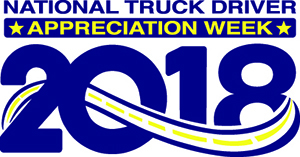Opinion: Salute the Heroes Who Drive Our Economy
America is blessed with one of the strongest economies in the world. As a nation, we churn out nearly $20 trillion in annual domestic product. We are home to a diverse set of industries, providing a foundation of opportunity sought by so many around the world. And today a spirit of renewed optimism and favorable conditions are carrying us forward, away from the Great Recession and toward a period of revitalization and expansion, marked by 4.2% growth in the second quarter.

Spear
It’s been said success has many parents, and it’s true that many hands from across all sectors play a vital role in powering our economic machine. However, there is one group of people operating on the front lines of our forward-moving economy. If not for these professionals, our quality of life would not be possible. Without their hard work and sense of duty, day in and day out, our economy would grind to a halt. They are America’s professional truck drivers.
These unsung heroes form the backbone of the American economy. Virtually every product we touch, consume and rely on in our daily lives can be traced to the back of a truck. Everyone knows those trucks don’t drive themselves. But what is too often overlooked is that the safe and timely delivery of each load is only made possible by the men and women who operate them.
The job is not easy. It demands a strong constitution, commitment to safety, dedication to service and periods of personal sacrifice. Time on the road away from home puts strain on them and their loved ones. Yet they assume the duty with a powerful purpose in mind: to provide — for themselves, for their families and for every one of us who enjoy the bounty and abundance of this economy.
Americans must see trucks as far more than large vehicles sharing the road. Indeed, they represent some of the very best qualities of the American character, embodied by the professional who sits behind the wheel.
2018 NTDAW

A compilation of events thanking drivers during 2018 National Truck Driver Appreciation Week.
The week of Sept. 10 we celebrate National Truck Driver Appreciation Week, an annual occasion to spread this message from coast to coast. For those of us in the industry and working on its behalf, we have a responsibility to lead the conversation. It can be done in ways small and large. Talk to your friends and neighbors. Engage members of the media and others with a platform.
Duty deserves recognition, and sacrifice must be met with gratitude. Together, we can heighten the place of truck drivers within the national consciousness.
Perhaps NTDAW 2018 is timelier than years past, as our industry grapples with an acute driver shortage. This challenge has put a spotlight on truck driving, as more and more older drivers retire and fewer from the younger generations opt to take their place. If left unaddressed, this trend will create a significant roadblock for economic growth.
Appreciation for our drivers can no longer be seen as merely an awareness campaign. Rather, it is an urgent imperative that our industry and policymakers at all levels must embrace, plan for and strategize around.
I recently had the honor of visiting the USS Abraham Lincoln, a $4 billion warship. While on the deck during flight operations, I witnessed the captain command the helmsman to turn the aircraft carrier: “20-degree right rudder.” A female sailor, 18 years of age, swiftly carried out the order, maneuvering the 100,000-ton vessel.
Although in 48 states 18-year-olds are legally permitted to drive tractor-trailers intrastate — and while our military trains teens to fight wars and operate the heaviest of machinery in combat zones — our federal government prohibits these same individuals from driving a truck across state lines. That means an 18-year-old can operate her rig thousands of miles back and forth across a large state, but she cannot take the load a few miles into a neighboring state to make interstate deliveries.
If we can send young talent off to fight for our freedom, then we can train them to drive across state lines.
Instead, high school graduates who forego college are being drawn away from trucking to other industries such as construction, food service and retail. By denying them access to this profession at the start of their careers, the national driver shortage will only grow more severe. As we pause this week to share appreciation for our driver force, we must also push policymakers to acknowledge and appreciate the opportunities this profession can present for that vital, job-seeking 18- to 21-year-old population — as well as for the wider economy that’s placing their services in ever-growing demand.
Thanks to the industry’s 3.5 million professional truck drivers, the trucking industry today is in a position of strength. A strong trucking industry moves America forward, and the story of the American truck driver is as important as any in our economy today. It’s incumbent on us to tell that story. It would serve everyone well to listen.
American Trucking Associations is the largest trade federation in the trucking industry and has headquarters in Arlington, Va., as well as affiliated associations in every state. ATA owns Transport Topics.

